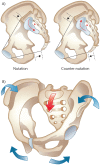A painful unknown: sacroiliac joint diagnosis and treatment
- PMID: 33204512
- PMCID: PMC7608515
- DOI: 10.1302/2058-5241.5.190081
A painful unknown: sacroiliac joint diagnosis and treatment
Abstract
The sacroiliac joint (SIJ) is a complex anatomical structure located near the centre of gravity of the body.Micro-traumatic SIJ disorders are very difficult to diagnose and require a complete clinical and radiological examination.To diagnose micro-trauma SIJ pain it is recommended to have at least three positive provocative specific manoeuvres and then a radiologically controlled infiltration test.Conservative treatment combining physiotherapy and steroid injections is the most common therapy but has a low level of efficiency. SIJ thermolysis is the most efficient non-invasive therapy.SIJ fusion using a percutaneous technique is a solution that has yet to be confirmed on a large cohort of patients resistant to other therapies. Cite this article: EFORT Open Rev 2020;5:691-698. DOI: 10.1302/2058-5241.5.190081.
Keywords: diagnosis; dysfunction; micro-traumatic pains; minimally invasive fusion surgery; sacro-iliac joint (SIJ).
© 2020 The author(s).
Conflict of interest statement
ICMJE Conflict of interest statement: J-CLH reports travel/accommodation/meeting expenses from Medtronic, Safeorthopaedics and Seaspine, outside the submitted work. The other authors declare no conflict of interest relevant to this work.
Figures






References
-
- Le Huec JC, Tsoupras A, Leglise A, Heraudet P, Celarier G, Sturresson B. The sacro-iliac joint: a potentially painful enigma. Update on the diagnosis and treatment of pain from micro-trauma. Orthop Traumatol Surg Res 2019;105:S31–S42. - PubMed
-
- Paquin JD, van der Rest M, Marie PJ, et al. Biochemical and morphologic studies of cartilage from the adult human sacroiliac joint. Arthritis Rheum 1983;26:887–895. - PubMed
-
- Solonen KA. The sacroiliac joint in the light of anatomical, roentgenological and clinical studies. Acta Orthop Scand Suppl 1957;27:1–127. - PubMed
-
- Nakagawa T. [Study on the distribution of nerve filaments over the iliosacral joint and its adjacent regio n in the Japanese]. Nihon Seikeigeka Gakkai Zasshi 1966;40:419–430. - PubMed
Publication types
LinkOut - more resources
Full Text Sources
Other Literature Sources

